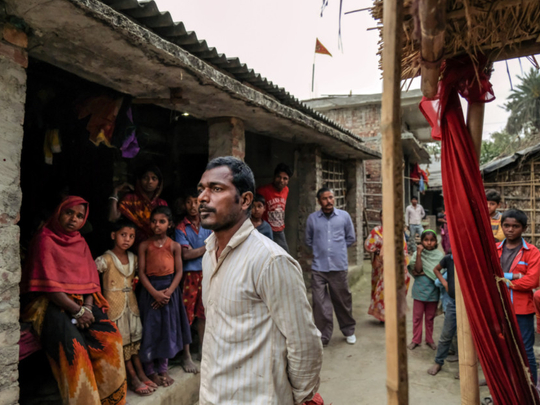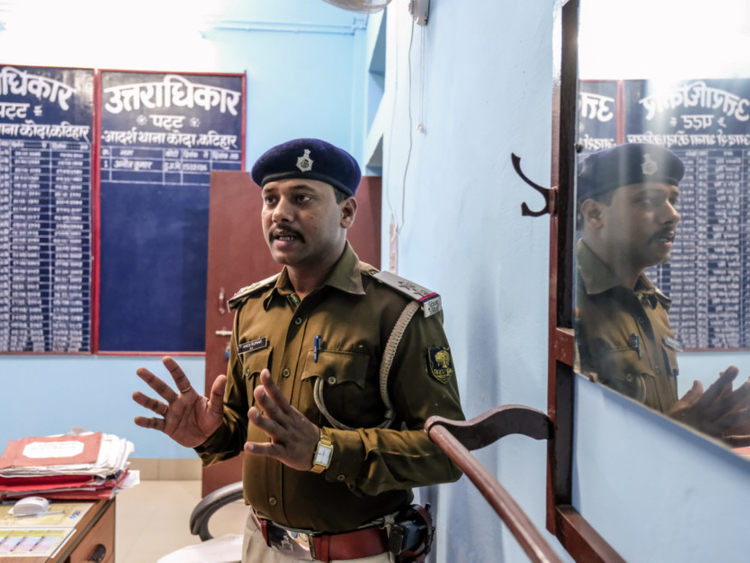
The well-wishers had all gathered even though neither the teenage bride-to-be nor her mother wanted the girl to go through with the wedding. It took a police raid to stop it, and even then it was nearly too late.
It is hard to state the age of Deepa Kumari, the betrothed girl, with any certainty. A government identification card lists it at 15. Her father, accused of selling Deepa for Rs20,000 (about $300) to the groom, a 31-year-old labourer, insists that she is 17. A local constable put the number at 13.
In any case, by dusk on that February evening, a group of plainclothes police officers stormed the village of Madhura in Bihar state. They chased men into fields and detained the bride and groom, already covered in turmeric powder to prepare for the ceremony, for further questioning.
Speaking to reporters at the police station later, Deepa Kumari, with downcast eyes, made her position clear: “I will not marry, sir,” she said. “I want to study.”
India’s child marriage rate is one of the highest in the world, with a long list of social and economic pressures, from poverty to a dearth of education opportunities, propping up the number. But as awareness has spread about the detriments associated with underage marriages, and as the authorities have responded more diligently, the prevalence has dropped. In some areas, it has done so sharply.
Data released by Unicef recently found that a girl’s risk of marrying before her 18th birthday in South Asia fell by more than a third in the last decade, from nearly 50 per cent to about 30 per cent, in large part because of progress in India.
Child marriage here is finely threaded with other practices, including the exchange of a dowry from the bride’s family to the groom, and sometimes with sex trafficking, making it difficult to tackle any one issue without addressing others. Social workers said there are no easy solutions.
“You cannot wave a magic stick,” said Anand Madhab, principle consultant at the Gender Resource Center, an organisation that supports women’s empowerment. “It’s a deep-seated problem.”
Bihar, a poor, agrarian state in northern India, has one of the highest rates of underage marriages in the country, according to India’s National Family Health Survey. In 2005, 69 per cent of surveyed women said they married when they were underage. Ten years later, the number fell to 42.5 per cent.
Last year, the Bihari government launched its own campaign to crack down. The chief minister, Nitish Kumar, dispatched social workers to villages and cities across the state, and announced that priests who officiate weddings would be required to sign declarations affirming that both parties are of legal age to marry. The legal age for marriage for Indian women is 18 years old. For men, it is 21.
With the 2006 Prohibition of Child Marriage Prevention Act, Indian lawmakers criminalised child marriage, imposing a jail sentence of up to two years or a fine for offenders.
Still, there is a long way to go. Many child marriages are unreported, and while police have clamped down on the practice in Bihar, more aggressive surveillance could be pushing illegal marriages underground and untraceable. Though India’s numbers are promising, a recent analysis of census data highlighted another disturbing finding. In pockets of India, incidents of child marriage are decreasing in rural areas, but increasing in urban settings.
Researchers involved with the study say it is unclear what is causing that phenomenon. One hypothesis is that an uptick in migration from villages to cities could mean that these weddings have simply been redistributed.
In order to curb the figures, Madhab said laws must complement locally generated pressure among neighbours to hold each other accountable. He likened the push to stamp out child marriage with another sweeping initiative, the banning of liquor in Bihar in 2016, which worked because it tapped into “fear psychology”, he said. “People consuming the liquor, they are very scared,” he said. “They think they are not doing the right thing, they think they are doing wrong.”
But unlike consumption of alcohol, child marriage is socially accepted in parts of India, where there is a belief that marrying daughters off at a young age shields them from unwelcome sexual advances and consolidates families’ status in a community.
At a police station near Madhura, Anoj Kumar, the head officer, said this part of Bihar has evolved. Leaning over the criminal complaint lodged against Suresh Chaudhary, Deepa’s father, he noted that other villagers were against the union.
“Even Deepa’s mother disagreed with the marriage,” he said. “Suresh said he was marrying her off because of poverty.”
A few miles away, in Madhura, Chaudhary told his side of the story through clenched teeth, balling a pink stole with his fist. “Nobody gave any money,” he said. “Society said that we were marrying the girl off by force. Someone from the outside complained.”
When the police disrupted wedding preparations, on February 5, Chaudhary avoided arrest by sprinting into a nearby cornfield and waiting out the night. He remained in hiding for two weeks.
Pressed about his daughter’s age, Chaudhary said he shaved off two years on government documents to give her an advantage in school. As for Deepa’s police statement that he tried to marry her against her will, Chaudhary posed a rhetorical question: “Now, she is scared of the police. How can she say she wants to get married?”
Amused with the scrum that had formed around Chaudhary, a man in a white dhoti spoke up in English from the back of the crowd, announcing himself as Kailash Mishra, the landowner who employed the girl’s father in his fields.
Mishra understood that Chaudhary was technically a man on the run. But he credited him with being a “very good guy, very gentle guy” who happened to be caught doing something virtually everybody else in the village was guilty of.
“The parents are scared,” he said. “They are fearing that if a daughter grows up, she’ll meet some boys on her own.”
There was one part of the police investigation that Mishra said he could not dispute. As night fell on Madhura, Chaudhary sounded a halfhearted call for Deepa to make an appearance. When no one came forward, Mishra cracked a smile.
“She must be hiding,” he said. “She didn’t want the marriage. She’s happy. What was supposed to happen has not happened.”
–New York Times News Service













